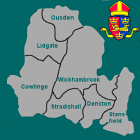  |
 |
 |
 |
 |
| Sat 27 Dec 2025 |

Rector's View - June 2014Dear friends, Great interest has been shown recently in our medieval graffiti at St Mary's Lidgate, though too we have noted examples at St Margaret's Cowlinge, and for those of you who would like to take a look - http://www.medieval-graffiti-suffolk.co.uk/page72.html. What you will see on the website is much clearer than what you would see in church, as the images use lighting and enhancement techniques. But what are these marks trying to say? Much more than the rather dull tagging we see about our city centres today! (take a look at - http://www.medieval-graffiti-suffolk.co.uk/page8.html for interpretation). What is common to today's spray tagging and medieval scratching is that both are meant to be seen where people will pass by or gather. Today's tags use the bright eye catching colours of our auto industry, in medieval times the church itself was brightly coloured and the graffiti stood out as clear white scratches incised in the stone against the usual red ochre wash. The revelation to us is to see clear just how much our churches were gathering and meeting places for our villagers as so much are they absent today, our heritage still greatly valued but rarely entered. Today's graffiti is all about the individual, so much so we take notice when street art says something more than 'I wuz 'ere''. Medieval graffiti too was about individuals but rarely the one making their mark, Daisy Wheels, Saints, Knots, Ships, Windmills, all these were directed toward individuals for their blessing or testing, for protection for justice for promises made not to be broken, today's love hearts in tree bark but a faint echo of those richer prayers. For prayer is the sign we see left from generations past, the daisy wheel or knot seeks to divert all ill design from the lives of those bought to church in baptism, rather like our motorway interchanges today which speed us through difficult junctions, demons would follow the never ending circles set in stone and the baptised would be freed from their interference. Other signs follow similar intent either to bless protect or call for God's justice in righteous judgement against oppressors. Whilst today's interest in these prayers is largely from secular groups or academics I hope our villages may rediscover this once commonly valued sign of our prayer life, that church may again be a place of gathering and meeting that we may look for God's direction in the course of our lives.
Revd Brin Singleton |

